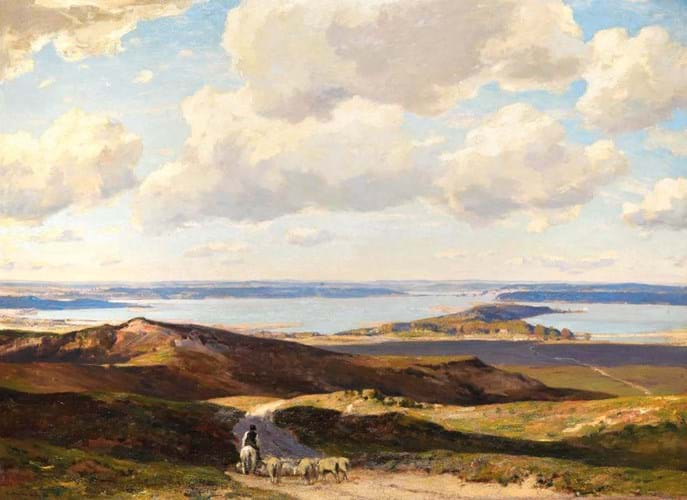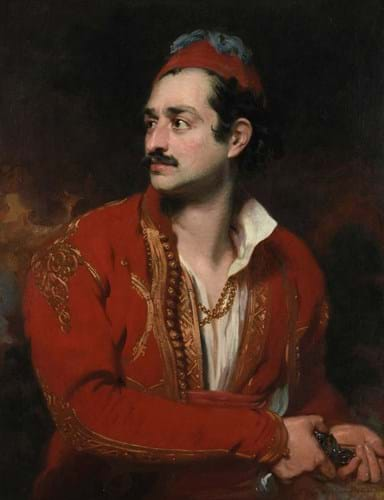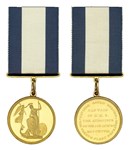Among the notable results for pictures sold in the regions at the end of last year was a handful of works that sparked competition at Dreweatts’ (25% buyer’s premium) latest Old Master, British and European Art auction.
While the £70,000 Jacobean portrait of two young brothers was the star attraction at the Newbury sale on December 14 (see News in ATG No 2573), another portrait dating from a couple of centuries later also turned a few heads.
The painting from 1833 was by Henry Wyatt (1794-1840), a pupil of Thomas Lawrence. It depicted a moustachioed man dressed as a fictional literary hero.
It was titled The Corsair, fire in his glance and wildness in his breast – a subject taken from one of Lord Byron’s epic poems. Byron’s The Corsair tells the tale of the privateer Conrad who ends up being “linked with one virtue and a thousand crimes”. It was an extremely popular work, selling 10,000 copies on the first day after it was published.
The story remained influential throughout the 19th century, inspiring a myriad of other works such as the opera Il Corsaro by Giuseppe Verdi, the overture Le Corsaire by Hector Berlioz and the ballet of the same name by Adolphe Adam.
While commissioned portraits were Wyatt’s stock-in-trade, he also produced genre scenes and the occasional portrait based on historical and literary figures such as this. To a lesser extent, he tried his hand at landscapes, tree studies and architectural sketches that occasionally appear at auction today, mostly selling for under £1000.
During his time working in Lawrence’s studio (where his annual salary of £300 indicated his importance as an assistant) he produced some admired copies of his master’s best-known portraits. But after branching out on his own in 1817 he established a successful independent practice, first in Birmingham, then Liverpool, then Manchester, before returning to London in 1825 and setting up a studio in Newman Street.
Supporters would say his works deserve to fetch substantially more than those of just a mere copyist. However, before this sale, he had never broken through the £10,000 barrier in terms of auction prices.
The 2ft 11in x 2ft 4in (90 x 70cm) signed oil on canvas at Dreweatts was a relatively late example of his work. In fact, within a year of finishing it, Wyatt left London on account of his severe asthma (he died near Manchester six years later). The picture was therefore a mature work which was not only an attractive proposition due to its subject matter – a charismatic portrait of a Byronic hero – but also because it had plenty going for it on a technical level too.
The striking composition and convincing lifelike physiognomy, as well as the handling of the colourful attire, made it arguably the best demonstration of the artist’s considerable skill that had ever emerged at auction.
It was actually a known work, having appeared at an exhibition at the V&A back in 1975 and also having a provenance to London dealer Agnews.
The condition added to its appeal – although it had some scattered retouching visible under UV light, it was in a good state of preservation.
This combination of factors ensured that, on the day, it drew strong interest from a number of bidders and flew over a £12,000-18,000 estimate.
It was eventually knocked down at £52,000 to a European collector, setting the highest price at auction for the artist by some distance, according to Artprice. The previous record for Wyatt was the £9000 for a painting titled The Gentle Reader that sold at Sotheby’s back in 2001.
Location, location, location

Studland Bay with Poole Harbour in the distance by Sir Herbert Hughes-Stanton, £38,000 at Dreweatts.
Another record for a British artist came for a coastal scene by Sir Herbert Hughes-Stanton (1870-1937).
Again, the subject matter raised the work well above the ordinary.
Here, it was the location that mattered. The 3ft 10in x 5ft 4in (1.11 x 1.63m) oil on canvas depicted Studland Bay – part of a four-mile stretch of sandy coastline sometimes described as a jewel of Dorset (it also includes one of Britain’s most famous naturist beaches). Poole Harbour was visible in the distance, a longtime favourite destination for the well-heeled yachting and boating community.
Hughes-Stanton was predominantly a landscape painter who, as well as painting the English countryside, also produced views of Greece and rural France. He was the son of the still-life artist William Hughes (1842-1901) and exhibited at the Royal Academy, the Grosvenor Gallery and the Fine Art Society, the latter dealership hosting a memorial exhibition dedicated to the artist shortly after his death.
This large and sweeping picture with an extensive sky was clearly a major work. It was exhibited at the Royal Academy in 1904 and had sold at Christie’s back in 1947. The artist did paint other views of Studland Bay but none on this scale or with this level of ambition had emerged before. A smaller picture, about a third of the size of the current work, sold at Herefordshire saleroom Brightwells for £1100 in 2016.
Indeed, most works by Hughes-Stanton tend to sell for sums around that kind of level or even below. Before this sale, he had broken the £10,000 barrier only once – a painting of the medieval village of Haut de Cagnes in the south of France that took £12,500 at Sotheby’s sale of the Leverhulme collection in 2001.
Here the estimate was £6000- 8000 and, after a fervent bidding battle broke out, it sold at £38,000 to an online buyer, setting a major record.
Still-life turns heads
Elsewhere at the sale, one of the European pictures at Dreweatts that drew competition was a vintage still-life by German painter Johann Wilhelm Preyer (1803-89). One of the early members of the Düsseldorf school of artists, he worked meticulously to produce detailed paintings of flowers and fruit in the tradition of earlier Dutch artists such as Pieter Claesz and Rachel Ruysch.
The 14¼ x 12in (37 x 33cm) signed oil on canvas from 1865 was a trademark example showing a draped ledge with grapes, peaches, apricot, hazlenuts and a champagne flute – the latter being a common feature in his work. An exquisitely painted fly appears on the grapevine.
The small size of the work was highly typical, so did not detract from it commercially.
The same was true of its condition – the canvas was in a decent state despite some minor surface cracks and retouching.
While a couple of similar pictures by Preyer have tipped over £80,000 at sales in Germany and the US, here the estimate was set at £30,000-50,000. It was knocked down at £48,000 to a European dealer, the highest price for the artist at a UK auction held outside London.
















